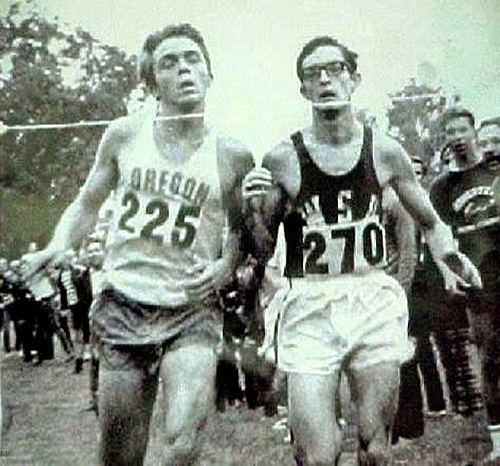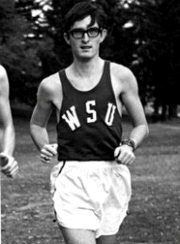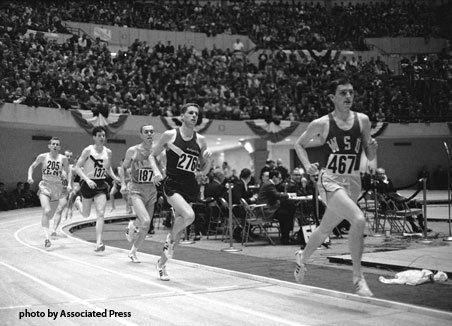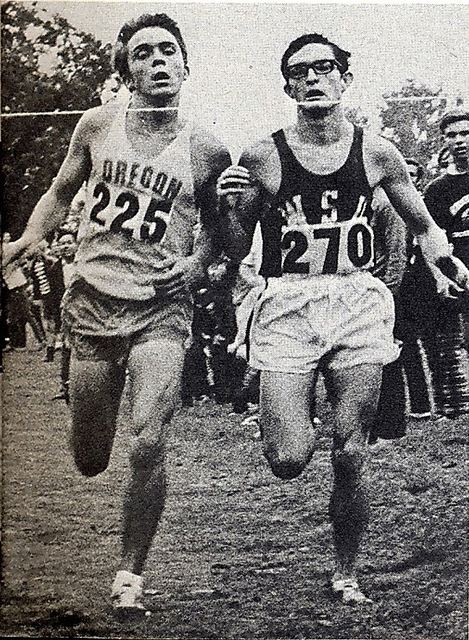Nationality American Sport Track | Name Gerry Lindgren | |
 | ||
Event(s) 3000 meters, 5000 meters, 10,000 meters College team | ||
1970 gerry lindgren vs frank shorter kerry o brien in a 2 mile race
Gerald "Gerry" Paul Lindgren (born March 9, 1946) is an American track and field runner who set many long-standing high school and national records in the United States. In 1965, Lindgren and Billy Mills both broke the world record for the six-mile run when they finished in an extremely rare tie at the AAU National Championships, both running exactly 27:11.6. Lindgren went on to win a record 11 NCAA collegiate championships with Washington State University.
Contents
- 1970 gerry lindgren vs frank shorter kerry o brien in a 2 mile race
- Gerry lindgren 1971
- High school
- The Summer Olympics and After
- Collegiate and retirement
- High school personal records
- College personal records
- NCAA Championships
- Beliefs
- References

Gerry lindgren 1971
High school

In 1964, in his senior year at Rogers High School, Lindgren ran 5000 meters in 13 minutes and 44 seconds flat, on a clay track in Compton, CA setting a U.S. high school record for the distance that would remain unbroken for 40 years, until Galen Rupp ran 13:37.91 on July 30, 2004 on a modern synthetic surface in European competition. Among his other records he established that year was his time of 8:40.0 in an indoor 2-mile (3.2 km) race that shattered the previous U.S. national high school mark by an incredible 43 seconds; it was the fastest high school 2-mile (3.2 km) time ever run indoors until February 16, 2013 when Edward Cheserek (age 19) ran 8:39.15 at the Millrose Games. As Cheserek's record was set on a 8-laps to a mile banked track, Lindgren's only slightly slower time is all the more remarkable, as it was run 49 years earlier on a wooden 11-laps to a mile track which is no longer in use because of its tighter turns and inferior results.

Lindgren was coached by Tracy Walters in high school, where Walters was responsible for inspiring Gerry to the heights he reached. In the summer following high school graduation and his historic 13:44 5k, Lindgren ran 200 miles a week for 6 weeks in preparation for the US-USSR meet. After that victory he also set a new teenage record of 13:17.0 for 3 miles while competing in Jamaica, a meet where he ran his mile best of 4:01.5 as well, both on a dirt track. Lindgren's greatest gift was his unending capacity for hard work, as well as his prodigious recuperative powers. Where most runners would have been completely broken by the massive mileage amounts Lindgren ran, Gerry thrived on it and only became faster. He inspired a generation to train hard and give everything to the race.

On July 25, 1964, Lindgren outran two seasoned Russian runners, Leonid Ivanov and Anatoly Dutov to win the 10,000 meter event in the US-USSR Track Meet in Los Angeles. See the end of the race @ 1:52 Video on YouTube The event heralded the greatest year ever for American distance runners. The ensuing 12 months brought forth 2 gold medals by Americans, in both the 5000 and 10,000 meter events in Tokyo, as well as World Records in the 2-Mile, 6-mile and indoor Mile. Lindgren won the Olympic Trials that summer as an 18-year-old, but an ankle sprain just before the Olympic Finals hampered his chances for a medal, where he was favored to make the podium. He was Track and Field News "High School Athlete of the Year" in 1964.
The Summer Olympics and After

In the 1964 Summer Olympics in Tokyo, he finished ninth in the 10,000 meters behind gold medalist Billy Mills after having sprained an ankle during training. Lindgren had previously beaten Mills in the Olympic Trials that year. Mills later said that a healthy Lindgren would have won gold. Four years later, Lindgren tried to make the 1968 Olympic team but finished 5th in the 10,000 meters and 4th in the 5,000 meters in the Olympic Trials at Echo Summit, just missing the team at both distances because of a painful Achilles tendon injury. In his training just after college, he averaged 240 miles per week for one year, including running a 380-mile week.
Lindgren also competed against Mills in the 1965 AAU Nationals meet, where they raced the 6-mile (9.7 km). Mills won with a diving lean, while both were timed in 27:11.6, a new World Record shared by Mills and Lindgren. The mark was also superior to the then-WR for 10,000m of 28:15 held by Ron Clarke. T&F News converted their mark to 28:10. But perhaps Lindgren's greatest race came during a May 1966 NCAA Regional meet at age 20, in the 3-mile run on a dirt track during a cold, windy day in Seattle. He raced to 12:53.0, just missing the World Record of 12:52.4 held by Ron Clarke. Both times were superior to the current 5000m WR of 13:24. T&F News converted his time to 13:21. No American before or since has come as close to the 3-mile/5000m WR.
Collegiate and retirement
Lindgren attended Washington State University in Pullman, Washington, where he majored in political science and minored in Russian language. While at Washington State, Lindgren won 11 NCAA Championships. (His only loss at an NCAA championship was to Jim Ryun in the 1968 indoor 2-mile (3.2 km) race.) He was one of only two people to ever defeat Steve Prefontaine in an NCAA Championship. (Lindgren won the 1969 NCAA Cross Country Championship in which 1968 NCAA champion Mike Ryan finished second and Prefontaine third.) He competed sporadically after graduating from college but without any notable success. Since 1980, Lindgren has lived in Honolulu, Hawaii. He continues to run regularly, active in the Hawaii running community. He coached the University of Hawaii's women's track and field team 2005–2007.
High school personal records
College personal records
NCAA Championships
Beliefs
Lindgren has reiterated his belief is "Karma" as a large factor in his running success. He claims that "Karma comes from serving other people instead of serving yourself. I found that if I could serve others people without them knowing about it I could grow Karma faster," and that this would lead to success on the track.
